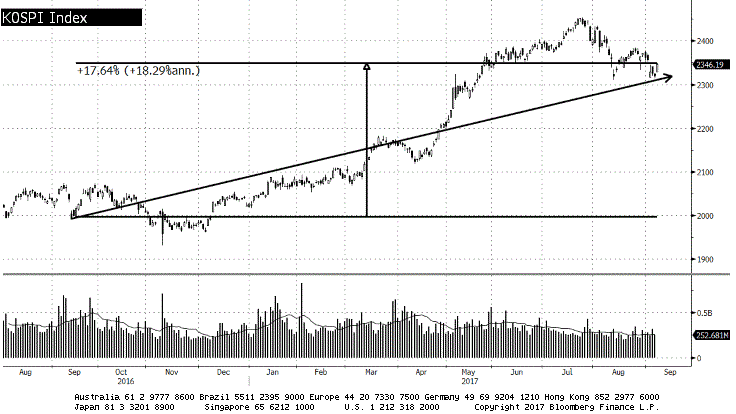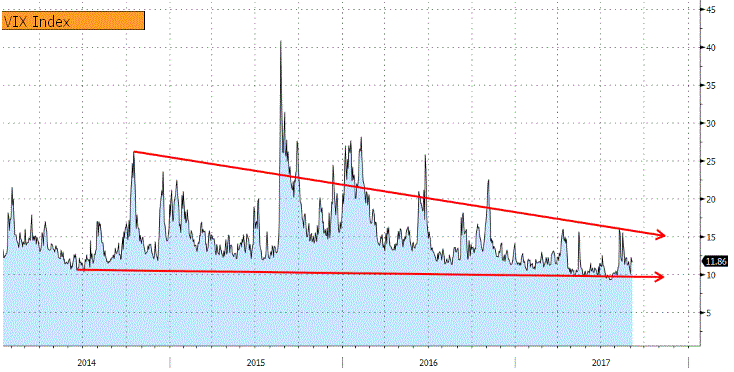Threat from North Korea: This time is not different. Investors beware!
North Korea from 1976 to today: Has anything really changed?
North Korea has a longer history of missile testing than many of us can recall. It has been 41 years since the launch of its missile development programme in 1976.
During this time span, they have expanded and upgraded their arsenal from the tactical ballistic Scud missiles that has a 500km range, to an inter-continental ballistic missile, Taepo Dong 2 with a range of 10,000km.
It might not take too long before the North Korean regime achieves miniaturization of nuclear warheads on the ICBMs. And many experts and analysts have opined that this is highly possible, regardless of sanctions or no sanctions status.
As of now, more than two-thirds of the world is within range of Taepo Dong 2 (see map above).
History of North Korea’s Missile Development Programme
1976-81: Begins missile development using Scud-B
2006: 1st nuclear missile test
2017: Aug 29, North Korea launched a ballistic missile over Northern Japan
Many countries have condemned the latest test in Aug 29. While further sanctions are being contemplated, Putin has remarked that they are pointless - he remarked as a matter of fact, “They will prefer to eat grass than give up their nuclear program.“
In my opinion, this is very true.
The current situation was a few decades in the making, what could change by enforcing even tougher sanctions now? Will the nuclear warheads disappear or Mr Kim and company lose their spirits now, as if that their lives had not been greatly inconvenienced prior to all these talks?
We had witnessed the limitations of sanctions. Even though sanctions have been applied many times previously, they were neither enforced strictly nor monitored closely. See some of the sanctions on North Korea in the last decade below.
2006: Resolution 1718 demanded that North Korea cease nuclear testing
2009: Resolution 1874 broadened arms embargo
2013: Resolution 2087 broadened arms embargo; Resolution 2094 sanctions on money transfers
2016: Resolution 2270 banned the export of coal and iron, with an exemption for transactions that were purely for “livelihood purposes”; Resolution 2321, capped coal exports and banned exports of copper, nickel, zinc, and silver.
Neither can the economic noose be tightened completely in a manner that all countries can readily stand to “punish” the North Koreans. Retired General Wesley Clark, a former NATO Supreme Allied Commander shared how US sanctions in the 1930s furthered Japan’s resolution into a full scale war with USA, in a CNBC interview he shared,
“… there is one caution: In the late 1930’s the U.S. cut-off scrap iron and oil shipments to Japan. It was meant as a form of pressure to constrain Japan’s Asian aggression. But for Japan, it meant that war with the U.S. became necessary. There are limits to the efficacy of economic pressures; the economic destruction of North Korea, were it possible, is unlikely to compel its surrender and more likely to convince Kim he has little to lose from more extreme military action.”
Be wary of taking the middle ground, for it is not without barbs. Tacit acknowledgment of North Korea as a de facto nuclear power postulated by Russia was arguably a result of “coolheaded” choices and “strategic” negotiations by leaders, generations before. The current situation will spur an arms race, and worse still a dash towards nuclear proliferation in Asia.
Why should investors keep a close watch on North Korea?
In the financial markets, any escalation in risks will crash back to the normal levels, once immediate risks of armed conflict is dismissed. Similarly any deescalation will be a short term reversion, leading to a sharp knee jerked reaction spike on the next provocation (no matter how little or minute the risks are).
The danger here lies in the frequency of events leading to non-events, or such that global leaders and markets term as non-events leading to a perceived norm. The bolder traders will trade volatility in greater volumes. The emboldened investors will stay put after multiple ‘fire-drills’ and loss of spreads. What then when a real crisis occurs?
“Nonetheless, the price action also serves as yet another illustration of one of the markets’ distinguishing features in the recent past: resilience. And it is the result of behavior that, at least so far, has served traders and investors well when it comes to making money — that of buying on dips. This investor reaction is underpinned by strongly held beliefs in the marketplace regarding the underlying stability of global growth dynamics, … and the containment of adverse political spillovers.” Mohamed A. El-Erian shares his opinions in a Bloomberg interview.
Remember the parable of the boiling frog?
The financial markets may run the course of progressing from tolerating Kim’s provocations, to the acceptance of a ‘peaceful’ nuclearized North Asia. When we compare 1976 to now, and pause to think about now versus a nuclearized North Asia, neither situations are acceptable. Significant events have led to today’s nuclear developments. However the financial markets continue to thrive in self-delusional ‘containment’ as warned by El-Erian. Risks are perceived as low and thus underpriced. Financials in certain geographical and industry-sensitive segments have built up excessive liquidity.

Take for instance the Kospi that has shrugged off these fears and is even trending higher. Similarly, we see a very docile VIX. The resilience of the markets creates “resilient” participants, might be a self-reinforcing loop that is contributing to a high price, low return environment that cannot come to terms with inherently high risks.

War is clearly not an option for any side. US has no clear advantage and compelling reasons to execute first strike, especially so when North Korea and China share a mutual defense treaty, neither is it a dominant strategy for Kim to shoot US or anyone else; only to risk a “lose-all overnight”.
There is simply no optimal pay-out in this game of very high stakes poker. The current provocations and dare games will only increase the risk for missteps, as the leaders continue to berate each other and deploy show-of-force. This time is not different from 1976 or 2006. It is simply 2017.
Time to wake up and acknowledge the dangers. Long term investors should consider backing off.



